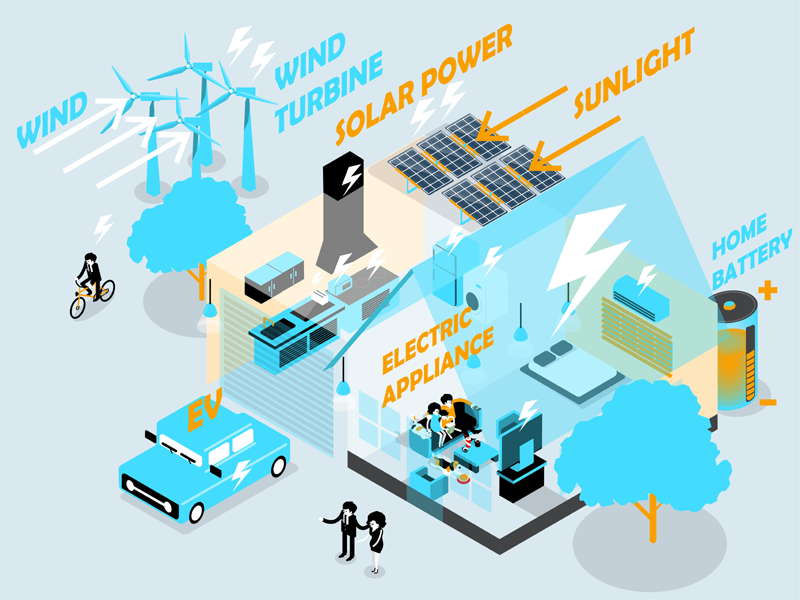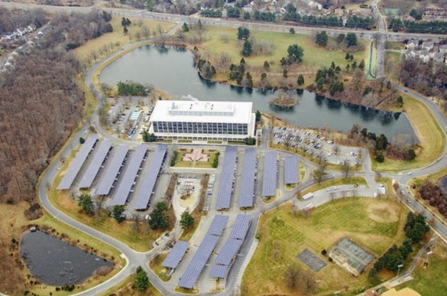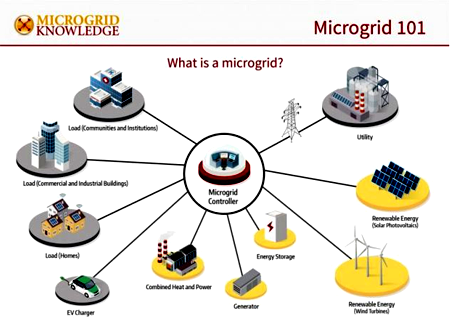
Trendy Energy Solution Microgrid Solution:
- Solar
- Back up Batteries
- Power Generator where needed
- Smart Energy Management System operating on Artificial Intelligence
- Power Factor Correction
- Harmonics Corrections
- Surge Suppression
- Hepa Filteration
- AC Refrigerant Oil
- Lighting Retrofit
Trendy Energy Solutions with the technologies, now use Microgrid as Prime Power thus saving Customers over 20% Monthly savings on their Energy Bill.
Definition and Overview of Mini Microgrids
How is a microgrid defined? A few different definitions exist. Here we set out to explain what we mean by ‘microgrid’ at Microgrid Knowledge.
Within microgrids are one or more kinds of distributed energy (solar panels, wind turbines, combined heat & power, generators) that produce its power. In addition, many newer microgrids contain energy storage, typically from batteries. Some also now have electric vehicle charging stations.

Interconnected to nearby buildings, the microgrid provides electricity and possibly heat and cooling for its customers, delivered via sophisticated software and control systems.
Microgrid defined by three key characteristics:
1. A microgrid is local
First, this is a form of local energy, meaning it creates energy for nearby customers. This distinguishes microgrids from the kind of large centralized grids that have provided most of our electricity for the last century. Central grids push electricity from power plants over long distances via transmission and distribution lines. Delivering power from afar is inefficient because some of the electricity – as much as eight to fifteen percent – dissipates in transit. A microgrid overcomes this inefficiency by generating power close to those it serves; the generators are near or within the building, or in the case of solar panels, on the roof.
2. A microgrid is independent
Second, a microgrid can disconnect from the central grid and operate independently. This islanding capability allows them to supply power to their customers when a storm or other calamity causes an outage on the power grid. In the US, the central grid is especially prone to outages because of its sheer size and interconnectedness – more than 5.7 million miles of transmission and distribution lines. As we learned painfully during what’s known as the Northeast Blackout of 2003, a single tree falling on a power line can knock out power in several states, even across international boundaries into Canada. By islanding, a microgrid escapes such cascading grid failures.
Learn about microgrids from those that build, operate and own them by joining us at Microgrid 2021: The World Awakens to Microgrids, a virtual conference hosted by Microgrid Knowledge. Participation is free if you register in advance. Space is limited and we are experiencing record sign-ups so please register now.
While microgrids can run independently, most of the time they do not (unless they are located in a remote area where there is no central grid or an unreliable one). Instead, microgrids typically remain connected to the central grid. As long as the central grid is operating normally, the two function in a kind of symbiotic relationship, as explained below.
3. A microgrid is intelligent
Third, a microgrid – especially advanced systems – are intelligent. This intelligence emanates from what’s known as the microgrid controller, the central brain of the system, which manages the generators, batteries and nearby building energy systems with a high degree of sophistication. The controller orchestrates multiple resources to meet the energy goals established by the microgrid’s customers. They may be trying to achieve lowest prices, cleanest energy, greatest electric reliability or some other outcome. The controller achieves these goals by increasing or decreasing use of any of the microgrid’s resources – or combinations of those resources – much as a conductor would call upon various musicians to heighten, lower or stop playing their instruments for maximum effect.
A software-based system, the controller can manage energy supply in many different ways. But here’s one example. An advanced controller can track real-time changes in the power prices on the central grid. (Wholesale electricity prices fluctuate constantly based on electricity supply and demand.) If energy prices are inexpensive at any point, it may choose to buy power from the central grid to serve its customers, rather than use energy from, say, its own solar panels. The microgrid’s solar panels could instead charge its battery systems. Later in the day, when grid power becomes expensive, the microgrid may discharge its batteries rather than use grid power.
Microgrids may contain other energy resources – combined heat and power, wind power, reciprocating engine generators, fuel cells – that add even greater complexity and nuance to these permutations.
Working together via complex algorithms, the microgrid’s resources create a whole that is greater than the sum of its parts. They drive system performance to a level of efficiency none could do alone. All of this orchestration is managed in a near instantaneous fashion – autonomously. There is no need for human intervention.

What a microgrid is not
It’s important to note here what a microgrid is not. Some people use the term to describe a simple distributed energy system, such as rooftop solar panels. A key difference is that a microgrid will keep the power flowing when the central grid fails; a solar panel alone will not. Many homeowners with solar panels are unaware of this fact and are surprised that they lose power during a grid outage.
Simple back-up generators also are not microgrids. Such systems are only employed in emergencies; microgrids operate 24/7/365 managing and supplying energy to their customers.
Side Note: The Department of Energy offers a more formal definition for a microgrid, describing it as a group of interconnected loads and distributed energy resources within clearly defined electrical boundaries that acts as a single controllable entity with respect to the grid. Microgrids can connect and disconnect from the grid to enable them to operate in both grid-connected or island mode.
How many microgrids and where?
Microgrids have been around for decades, but until recently were used largely by college campuses and the military. So, the total number of microgrids is relatively small but growing. Guidehouse (previously Navigant) forecasts that the market will near $39.4 billion by 2028.
But the pace of installation has picked up and is expected to grow dramatically as distributed energy prices drop and worries heighten about electric reliability, due to severe storms, cyberattacks and other threats.
Guidehouse expects global microgrid capacity to reach 19,888.8 MW by 2028, up from 3,480.5 MW in 2019. The research firm sees North America and Asia Pacific as the centers of growth.
